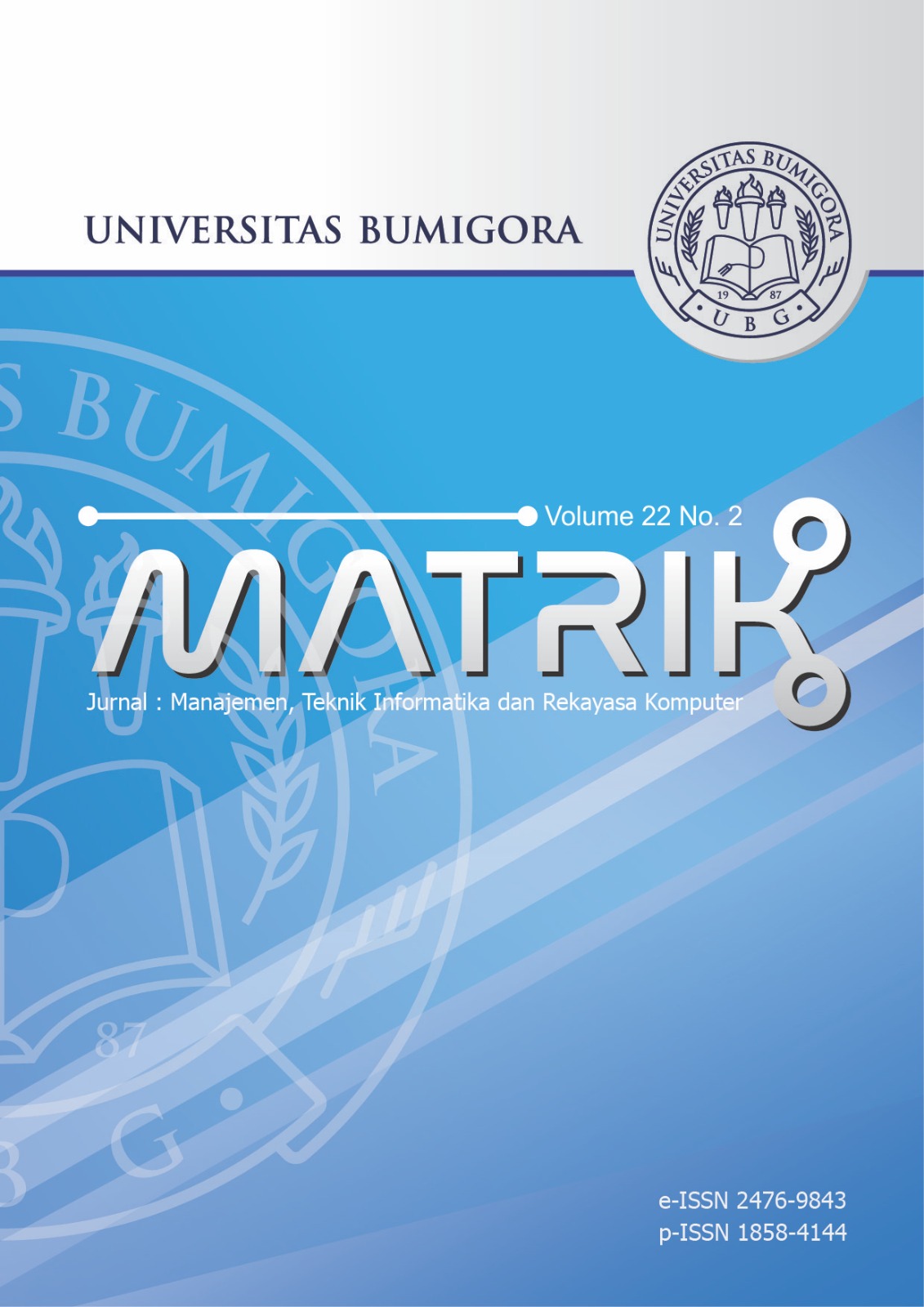A computational approach in analyzing the empathy to online donations during COVID-19
DOI:
https://doi.org/10.30812/matrik.v22i2.2396Keywords:
Computational social science, Empathy, Online donation, Twitter, COVID-19Abstract
The COVID-19 pandemic has a negative impact on many aspects of life. The global economic downturn is one of these negative consequences. Nonetheless, even though everyone feels the threat of this pandemic for themselves, some people still have the empathy to help others. An empirical analysis of this empathy attitude is expected to be a catalyst in realizing a social force for the community to work together to combat this pandemic. This study will look at how people felt about donating during the COVID-19 pandemic on Twitter. The goals of this study are to (1) compare differences in donor desire before and during the COVID-19 pandemic using the developed model, and (2) determine whether there is a significant difference in empathy for donating before and during the pandemic. This study employs computational social science (CSS) techniques to achieve this goal. The data was obtained from Twitter using the keyword "donation" in the 24 months preceding the pandemic and in the 24 months following the pandemic's arrival in Indonesia. Data analysis includes hypothesis testing using Mann-Whitney and Cohen's D statistical tests, showing a significant increase in online donation support among Indonesian Twitter users since the COVID-19 pandemic hit. From the results of data processing data obtained 159.995 data in accordance with the criteria to be analyzed. From the results of the Mann-Whitney test, all variables showed significant results between before and during the Covid-19 pandemic and in the results of the Cohen's d test, all variables got a large effect size. From the results of the two tests, it can open Twitter social media users who have increased empathy to donate during the Covid-19 pandemic in Indonesia
Downloads
References
Indonesia, Jakarta, 2021.
[2] Bappernas, Studi Pembelajaran Penanganan Covid-19 Indonesia, 2021.
[3] Peraturan Pemerintah RI, “Keputusan Presiden Republik Indonesia Nomor 12 Tahun 2020 tentang Penetapan Bencana Non-
Alam Penyebaran CORONA VIRUS DISEASE 2019 (COVID-19) sebagai Bencana Nasional.†2020.
[4] T. A. van den Broek, A. Need, M. L. Ehrenhard, A. Priante, and D. Hiemstra, “The Influence of Network Structure and Prosocial
Cultural Norms on Charitable Giving: A Multilevel Analysis of Movember’s Fundraising Campaigns in 24 Countries,†Social
Networks, vol. 58, no. April, pp. 128–135, 2019.
[5] Kominfo, “Indonesia Peringkat Lima Pengguna Twitter,†2012.
[6] F. M. Firmansyah and J. J. Jones, Did the Black Panther Movie Make Blacks Blacker? Examining Black Racial Identity on
Twitter Before and After the Black Panther Movie Release. Springer International Publishing, 2019, vol. 11864 LNCS.
[7] A. Kartino, M. Khairul Anam, Rahmaddeni, and Junadhi, “Analisis Akun Twitter Berpengaruh Terkait Covid-19 Menggunakan
Social Network Analysis,†Rekayasa Sistem dan Teknologi Informasi, vol. 5, no. 4, pp. 697–704, 2021.
[8] R. A. Abbasi, O. Maqbool, M. Mushtaq, N. R. Aljohani, A. Daud, J. S. Alowibdi, and B. Shahzad, “Saving Lives Using Social
Media: Analysis of the Role of Twitter for Personal Blood Donation Requests and Dissemination,†Telematics and Informatics,
vol. 35, no. 4, pp. 892–912, 2018.
[9] E. Mnif, K. Mouakhar, and A. Jarboui, “Blockchain Technology Awareness on Social Media: Insights from Twitter Analytics,â€
The Journal of High Technology Management Research, vol. 32, no. 2, p. 100416, nov 2021.
[10] H. H. Hidayat, A. Ardiansyah, P. Arsil, and L. I. Rahmawati, “Pemetaan Kata Kunci dan Polaritas Sentimen Pengguna Twitter
terhadap Kehalalan Produk,†MATRIK : Jurnal Manajemen, Teknik Informatika dan Rekayasa Komputer, vol. 21, no. 1, pp.
1–10, nov 2021.
[11] R. N. Aldekhyyel, S. Binkheder, S. N. Aldekhyyel, N. Alhumaid, M. Hassounah, A. AlMogbel, and A. A. Jamal, “The Saudi
Ministries Twitter Communication Strategies During the COVID-19 Pandemic: A Qualitative Content Analysis Study,†Public
Health in Practice, vol. 3, no. June, pp. 1–9, jun 2022.
[12] M. Kfoury, D. Landy, and S. Fourmentin, “Combination of DES and Macrocyclic Host Molecules: Review and Perspectives,â€
Current Opinion in Green and Sustainable Chemistry, vol. 36, no. August, p. 100630, aug 2022.
[13] S. Hinduja, M. Afrin, S. Mistry, and A. Krishna, “Machine Learning-Based Proactive Social-Sensor Service for Mental Health
Monitoring Using Twitter Data,†International Journal of Information Management Data Insights, vol. 2, no. 2, pp. 1–9, nov
2022.
[14] H. S. Hota, D. K. Sharma, and N. Verma, Lexicon-Based Sentiment Analysis Using Twitter Data. Elsevier Inc., 2021.
[15] A. Al-Thubaity, Q. Alqahtani, and A. Aljandal, “Sentiment Lexicon for Sentiment Analysis of Saudi Dialect Tweets,†in Procedia
Computer Science, vol. 142. Elsevier B.V., 2018, pp. 301–307.
[16] F. A. Effendi and Y. Sibaroni, “Sentiment Classification for Film Reviews by Reducing Additional Introduced Sentiment Bias,â€
Jurnal RESTI (Rekayasa Sistem dan Teknologi Informasi), vol. 5, no. 5, pp. 863 – 875, 2021.
[17] N. P. Dewi and Ubaidi, “Lexical Rule dan Pengaruh Penggunaan Lexicon pada Pos,†Matrix, vol. 18, no. 1, pp. 65–72, 2018.
[18] T. Sriwidadi, “Penggunaan Uji Mann-Whitney pada Analisis Pengaruh Pelatihan Wiraniaga dalam Penjualan Produk Baru,â€
Binus Business Review, vol. 2, no. 2, pp. 751–762, nov 2011.
[19] A. Bowring, F. J. Telschow, A. Schwartzman, and T. E. Nichols, “Confidence Sets for Cohen’s d Effect Size Images,†NeuroImage,
vol. 226, no. February, pp. 1–28, feb 2021.
[20] F. M. Firmansyah and A. R. Pratama, “Anonymity in COVID-19 Online Donations: A Cross-Cultural Analysis on Fundraising
Platforms,†in Advances in Intelligent Systems and Computing, 2021, vol. 1364, no. April, pp. 34–47.
[21] F. Koto and G. Y. Rahmaningtyas, “Inset Lexicon: Evaluation of AWord List for Indonesian Sentiment Analysis in Microblogs,â€
in Proceedings of the 2017 International Conference on Asian Language Processing, IALP 2017, 2018, pp. 391–394.
[22] N. Rihhadatul’aisyi, S. Muthmainnah, H. P. Zahra, T. W. Putri, and F. T. Febrian, “Efek Twitter di Masa Pandemi COVID-19
pada Sikap dan Perilaku,†Jurnal Ilmu Komunikasi, vol. 19, no. 2, pp. 205–220, oct 2021.
[23] D. Purwitasari, A. Apriantoni, and A. B. Raharjo, “Identifikasi Pengaruh Pandemi Covid-19 terhadap Perilaku Pengguna Twitter
dengan Pendekatan Social Network Analysis,†Jurnal Teknologi Informasi dan Ilmu Komputer, vol. 8, no. 6, pp. 1309–1318,
nov 2021.
Downloads
Published
Issue
Section
How to Cite
Similar Articles
- Gallen cakra adhi wibowo, Sri Yulianto Joko Prasetyo, Irwan Sembiring, Tsunami Vulnerability and Risk Assessment in Banyuwangi District using machine learning and Landsat 8 image data , MATRIK : Jurnal Manajemen, Teknik Informatika dan Rekayasa Komputer: Vol. 22 No. 2 (2023)
- Susandri Susandri, Ahmad Zamsuri, Nurliana Nasution, Yoyon Efendi, Hiba Basim Alwan, The Mitigating Overfitting in Sentiment Analysis Insights from CNN-LSTM Hybrid Models , MATRIK : Jurnal Manajemen, Teknik Informatika dan Rekayasa Komputer: Vol. 24 No. 2 (2025)
- Apriani Apriani, Sandi Justitia Putra, Ismarmiaty Ismarmiaty, Ni Gusti Ayu Dasriani, E-Alert Application in Facing Earthquake Disaster , MATRIK : Jurnal Manajemen, Teknik Informatika dan Rekayasa Komputer: Vol. 19 No. 2 (2020)
- Didih Rizki Chandranegara, Faras Haidar Pratama, Sidiq Fajrianur, Moch Rizky Eka Putra, Zamah Sari, Automated Detection of Breast Cancer Histopathology Image Using Convolutional Neural Network and Transfer Learning , MATRIK : Jurnal Manajemen, Teknik Informatika dan Rekayasa Komputer: Vol. 22 No. 3 (2023)
- Tukino Paryono, Ahmad Fauzi, Rizki Aulia Nanda, Saepul Aripiyanto, Muhammad Khaerudin, Detecting Vehicle Numbers Using Google Lens-Based ESP32CAM to Read Number Characters , MATRIK : Jurnal Manajemen, Teknik Informatika dan Rekayasa Komputer: Vol. 22 No. 3 (2023)
- Dimas Afryzal Hanan, Ario Yudo Husodo, Regania Pasca Rassy, Sentiment Study of ChatGPT on Twitter Data with Hybrid K-Means and LSTM , MATRIK : Jurnal Manajemen, Teknik Informatika dan Rekayasa Komputer: Vol. 24 No. 2 (2025)
- Muchammad Ismail Hamzah, DESAIN DAN IMPLEMENTASI WEB SMP ISLAM NGEBRUK MENGGUNAKAN PHP DAN MYSQL , MATRIK : Jurnal Manajemen, Teknik Informatika dan Rekayasa Komputer: Vol. 16 No. 2 (2017)
- Ahmad Homaidi, Aplikasi Pengusulan dan Pemantauan Pelaksanaan Penelitian dan Pengabdian Masyarakat Universitas Ibrahimy , MATRIK : Jurnal Manajemen, Teknik Informatika dan Rekayasa Komputer: Vol. 20 No. 2 (2021)
- Safrian Aswati, M. Sabir Ramadhan, Ada Udi Firmansyah, Khairil Anwar, STUDI ANALISIS MODEL RAPID APPLICATION DEVELOPMENT DALAM PENGEMBANGAN SISTEM INFORMASI , MATRIK : Jurnal Manajemen, Teknik Informatika dan Rekayasa Komputer: Vol. 16 No. 2 (2017)
- Muhammad Rizki, Arief Hermawan, Donny Avianto, Learning Accuracy with Particle Swarm Optimization for Music Genre Classification Using Recurrent Neural Networks , MATRIK : Jurnal Manajemen, Teknik Informatika dan Rekayasa Komputer: Vol. 23 No. 2 (2024)
You may also start an advanced similarity search for this article.


.png)












